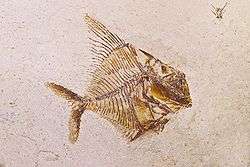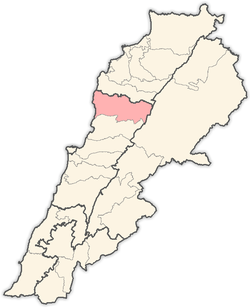Hjoula
Hjoula (Arabic: حجولا) is a municipality in the Byblos District of Mount Lebanon Governorate, Lebanon. It is 70 kilometers north of Beirut. Hjoula has an elevation of between 920 and 1,100 meters above sea level. Hjoula has a total land area of 528 hectares.[1] The village of Hjoula is known for its fertile soil and its woods, as well as Early Cretaceous fossils.
Hjoula حجولا | |
|---|---|
 Hjoula Location in Lebanon | |
| Coordinates: 34°8′8″N 35°44′29″E | |
| Country | Lebanon |
| Governorate | Mount Lebanon |
| District | Byblos |
| Area | |
| • Total | 528 ha (1,305 acres) |
| Elevation | 1,000 m (3,000 ft) |
Etymology
The word is an Aramaic one, however the meaning is uncertain. Most historians and linguists suggest it means "Oval" due to its oval shape, while some others speculate it comes from the Syriac root "G-l-a" and subsequently to the word "Guola" which supposedly means "The place of the wandering salesman".[2]
History
Many old relics and monuments were found in Hjoula. There was found a Phoenician inscription in "Jarabta". A Roman statue that represented a shepherd and his sheep was also found beside the lake, and was dated to the era of emperor Tiberius c. 20 CE; along small sets of coins that were written in Kufic with the inscription of Tripoli, probably dating to the Shiite Emirate of Tripoli (1079-1109). Furthermore, there is an old "Khirbeh" (ruins) called "Khirbet Ibrahim" (The Ruins of Ibrahim). After few centuries of the Islamic conquests, the population of mount Lebanon, especially Keserwan, and to a lesser extent, Byblos, was overwhelmingly Shiite in population and a strong dominion of Shiites was present in Keserwan and the fringes of Byblos for five centuries since the start of the 9th century and the rise of the Hamdanids, but it was bound to vanish during 1305 and the Shias were forced leave or adopt the practice of taqiyyah. Hjoula was essentially a Maronite village, inhabited by the known Abi Khalil family, which came from here. One of the famous Maronites from Hjoula was Gibrael Hjoula who was the Maronite patriarch until he was killed by the Mamlouks c. 1367 CE in Tripoli.[3] During the 15th and 16th centuries, Shiite families started spreading from Keserwan to Byblos and Bekaa after persecution under the Ottoman governors and tax collectors[4], and they became openly identifying as such and were known as the "Hamadiyyun" (Hamadas) because they served as the main body of support for the Hamade clan which became a tax collecting family in Munaytra, Byblos and the areas around, sharing historical and some times genealogical kinship with them. According to historical archives, Hjoula was a "Metouali" village during the 1519 census, and at 1569 it consisted of 9 houses. Hjoula paid a sizeable portion of its income tax towards Aqbay ibn 'Abdallah family vakif; its share rose from 200 g. upon the conquest, to 300 g. during Selim II's reign (1566-1574), to 1,600 g. by the mid-seventeenth century.[5]
Population
The village has a population of around 1900 inhabitants. The village has a population of around 1900 inhabitants. Here's an alphabetical listing of some of the families of Hjoula: Abi Nassif, Abi Raad, Alaa Ad-Din (Shibli), Assaf, Diab, Esber, Hjoula, Hmade, Ibrahim, Issa, Mahdi, Mrad, Nassif, and Qabalan.
Geology
Rock quarries near the village working Cretaceous age marine strata have produced a number of new fish and crustacean species along with rare cephalopods.[6]
 Aipichthys minor fish
Aipichthys minor fish Nematonotus species fish
Nematonotus species fish Carpopenaeus callirostris shrimp
Carpopenaeus callirostris shrimp- Homarus hakelensis lobster
 Artist reconstruction of Keuppia levante
Artist reconstruction of Keuppia levante
References
- "Hjoula". Localiban. Localiban. 2008-01-17. Retrieved 2016-02-12.
- https://books.rafed.net/view.php?type=c_fbook&b_id=2588&page=179
- http://hjoula.com/%D8%A7%D9%84%D8%A8%D9%84%D8%AF%D8%A9/%D8%A7%D9%84%D8%A8%D9%84%D8%AF%D8%A9-%D9%81%D9%8A-%D8%B3%D8%B7%D9%88%D8%B1
- https://en.wikipedia.org/wiki/Assaf_dynasty
- https://books.google.com.lb/books?id=KGeuAeFFJCEC&printsec=frontcover&dq=Shiites+of+Lebanon+under+Ottoman+rule+Hajula&hl=ar&sa=X&ved=0ahUKEwiCqqiijKDoAhULohQKHfHvC3kQ6AEILDAA#v=onepage&q=%20Hajula&f=false
- Fuchs, D.; Bracchi, G.; Weis, R. (2009). "New octopods (Cephalopoda: Coleoidea) from the Late Cretaceous (Upper Cenomanian) of Hâkel and Hâdjoula, Lebanon". Palaeontology. 52: 65–81. doi:10.1111/j.1475-4983.2008.00828.x.
